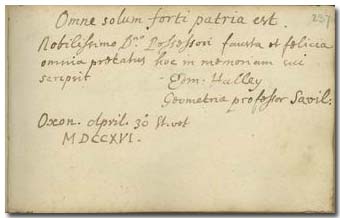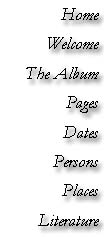
Omne solum forti patria est. *
Nobilissimo D[omi]no Possessori fausta et foelicia omnia praecatus
hoc in memoriam sui scripsit
Edm[undus] Halley
Geometriae professor Savil.
Oxon[iis] April. 30º st[ilo] vet[eri] MDCCXVI.
|
* Ovid, Fasti 1.493: “omne solum
forti patria est, ut piscibus aequor”.
|
|
|
Every land is homeland for the strong. *
I wish all kind of happiness and good fortune
to the owner [of this album], recommending myself into his memory
Edmund Halley
Savile Professor of geometry
In Oxford, on April 30, 1716, by the old calendar
|
p. 237. Oxford, May 11, 1716
Halley, Edmond
(1656-1742), English astronomer and
mathematician
Edmond
Halley was born on November 8, 1656 (by the old calendar, on October 29)
in the village of Haggerston near London (Shoreditch), the
son of the rich soap-maker Edmond H. He studied in St. Paul’s
School in London, and from 1673 in Queen's College Oxford. At that
time he already mastered Latin, Greek and Hebrew, and took
astronomical measurements and calculations. Some times he visited
in Greenwich the royal astronomer John
Flamsteed (1646-1719) who was working on a new catalogue of stars
on the basis of the most exact measurements of the period. This
intrigued Halley, who proposed to do similar measurements also on
the southern hemisphere. In November 1676 he broke his studies,
and with the financial support of his father and with letters of
recommendation of King Charles II he sailed on a ship of the East
India Company to the island of St. Helena, the southernmost point
of the British Empire on the Atlantic. In spite of wrong weather
he managed to determine the exact coordinates of 341 stars, to
observe the transit of the Mercure in front of the Sun, and to try
pendulum experiments. He set off for home in January 1678, and at
the end of the same year he published the first catalogue of
southern hemisphere stars. At this time he received M.A. degree on
royal command, and in November he was elected member of the Royal
Society. From 1713 he was the secretary of the Society, after
having edited its Transactions between 1685 and 1693. It
was in 1684 the first time he visited Newton in Cambridge. At that
time the problem of the movement of planets stood in the forefront
of interest. The laws by Johannes Kepler (1571-1630) were already
generally acknowledged, and now three members of the Royal
Society, Halley, Sir Christopher Wren (1632-1723, builder of St.
Paul's Cathedral in London) and Robert Hooke (1635-1703,
discoverer of the law of elasticity bearing his name) parallelly
researched the force keeping the planets in their orbit; Wren even
set a prize for the solution of the question. Hooke and Halley had
already calculated that the force was inverse to the square of the
distance between the planet and the Sun, but could not conclude
the orbit of the planet. At the visit of Halley to Newton this
latter disclosed to him that he had already achieved a
mathematical proof that the orbit concerned was elliptical.
Encouraged by Halley, Newton exposed his theory in his great
oeuvre, the Principia, cured and published by Halley in
1687 on the commission of the Royal Society and on his own costs,
also settling the dispute of precedence between Newton and Hooke.
In 1686 he prepared a map of the world showing the prevailing
winds over the oceans. It has the distinction of being the first
meteorological chart to be published. In 1693 he published the
mortality tables of the city of Breslau (Wrocław), in which
he was the first to attempt to relate mortality and age in a
population. In 1698-1700 he sailed to the southern part of the
Atlantic, and on the basis of the measurements by himself and
others in 1701 he published the first charts of the variation of
the compass in the Atlantic and Pacific oceans, giving the first
charts with lines of equal declinations plotted. In 1704 he was
appointed Savilian Professor of the chair of geometry at the
university of Oxford. (Sir Henry Savile (1549-1622) was a scholar
of ancient science, a traveller and the Greek professor of Queen
Elisabeth I; he founded the chair of geometry and astronomy in
Oxford in 1619.) Halley here translated from Arabic to Latin a
text by Apollonius, and reconstructed his lost books on the basis
of Pappus; he also edited Ptolemaeus and other ancient authors. In
1705 he deduced from the Newtonian laws of cometary orbits that
the comet appearing in the years of 1531, 1607 and 1682 is one and
the same, which will return the next time in 1758. It was in fact
observed at the end of 1758 with a perihelium in March of 1759.
This comet was later named after Halley; its period of revolution
is about 76 years, recurring in 1835, 1910, 1986 (its next return
is waited for 2062). In February 1721 Halley succeeded Flamsted as
Astronomer Royal. He died in Greenwich on January 14, 1742, and
was buried in the nearby Lee, in a common tomb with his wife Mary
Tooke (?-1737). His great merit was to have uderstood the results
of Newton, and also applied them on the movement of the comets; to
have published the Principia by Newton; and to have tested
the new scientific data in the practice, for example in
navigation. Some of his most important works are: Catalogus stellarum
australium … London, 1679. – An estimate of the degrees
of mortality of mankind drawn from curious tables of the births
and funerals at the city of Breslaw. London, 1694. – The
description and uses of a new and correct sea-chart of the whole
world, shewing the variations of the compass. London, 1700. -
Astronomiae cometica synopsis. London, 1705.
Halley in his note written in the album of Pápai Páriz indicates
his title of Savilian professor of geometry. Isaac Newton had
also made his note in the album of Ferenc Pápai Páriz on p.
109.
•
BritHung • DNB • EncBrit • Jöcher-Adelung • Michaud • MNL • Savile |

